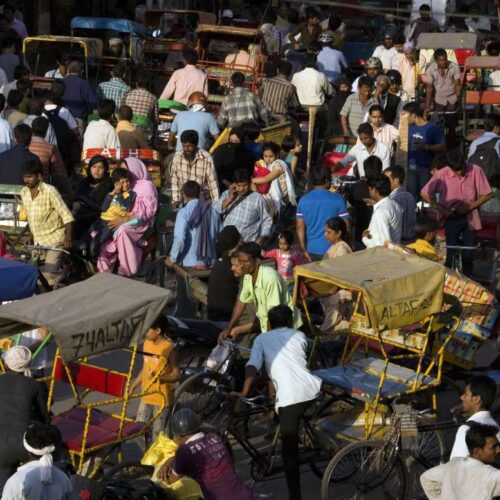Introduction
A U.S. government-sponsored family planning program in India has more than $40 million in the bank—and no one is sure what to do with it.
A report by the inspector general of the U.S. Agency for International Development says the idle money is a byproduct of poor management of the Innovations in Family Services Project, an otherwise successful 20-year-old effort to improve the quality and availability of family planning services in some of the poorest regions in India.
The pile of unused money got there because several years ago the project began falling behind on work and missing the mark on some of its goals. USAID’s rules governing the program say unused funds should be banked and then be returned to the U.S. agency. But there’s a snag: USAID officials in India believe the excess money actually belongs to the Indian government, which started its own population program to administer – and eventually replace – the American aid.
U.S. officials fear, however, that in Indian government hands the money may not be spent as planned. There’s a chance the funds will end up with another Indian population program that’s similar, but unrelated, to the American effort. Only this program has a history of corruption.
It’s a mess, according to USAID’s inspector general, that’s resulted from poor oversight of the family planning program by U.S. officials in India.
The controversy threatens the future of a USAID project that’s won praise for helping improve public health and family planning in India. Since the program began, mobile health vans have provided services such as ultrasounds and prenatal checkups to more than 30,000 people, while local sales of oral contraceptives have more than doubled. Without continued funding, the inspector general said, these gains could stall – a setback for India, the world’s second most populous country.
The 175 million people of Uttar Pradesh, where the program operates, make the state larger than all but five of the world’s countries. It is also one of India’s poorest locales. Since the inception of the USAID program, the average size of the family in India has shrunk to less than four people.
What to do with the money would not be so pressing if not for the uncertain future of the support program started by the state government – the State Innovations in Family Planning Services Project Agency.
By March 2012, that program, run by Uttar Pradesh state officials, is to become independent of the USAID and take over administration of the family planning project.
But SIFPSA has been beset by problems. A 2000 inspector general’s report cited major inaccuracies in data showing how many people it had provided family planning – data that was then used to establish new benchmarks and funding. Some data was overstated by as much as 168 percent.
“If SIFPSA ceases to exist, the $40.1 million in accumulated savings from the project could be absorbed by the Indian State Government Treasury and not be used for family planning-related activities,” the inspector general’s report said. “Therefore, it is imperative that USAID/India remains engaged with SIFPSA and the Indian Government to influence the use of funds.”
But that’s a problem. too. There are no transition plans in place to pass project responsibility from USAID to state officials in Uttar Pradesh.
USAID pledged to contribute $325 million to Uttar Pradesh over the life of the Innovations in Family Services project, with funds paid when the project met performance benchmarks such as expanding access to health care and contraceptives and increasing public acceptance of family planning.
But problems abound, according to the inspector general’s report, including a failure to hold Indian state officials to deadlines and setting unrealistically high standards. As of March, the Uttar Pradesh program had only reached 21 of 92 goals. USAID officials had canceled 45 others.
One reason for the shortfall: since 2005 India’s National Rural Health Mission, which now has many of the same objectives as the USAID initiative, has been operating in the same communities. The overlapping programs have robbed USAID of critical local NGO support to implement its programs.
The rural health mission also has been rattled by corruption scandals and poor management, according to the USAID inspector general. But because there’s no blueprint for transferring control of the family planning project from American control to is Uttar Pradesh counterpart, U.S. monitors fear the Indian project will fail and be replaced by the more controversial rural health mission.
USAID rules hold that if benchmarks go unmet, money allocated for them is placed in a savings account. But with the third and final phase of the USAID program scheduled to end next spring, the inspector general’s report questions how the Uttar Pradesh portion of the project has ended up with such a large quantity of surplus funds.
USAID overestimated the amount of money it would take to achieve many of the project’s benchmarks, with one overvalued by nearly $74,000, according to the inspector general’s report. Additionally, the project grant requires U.S. officials to review its performance each year – and adjust plans if need be. If money isn’t being used, it should be “deobligated.”
According to the report, USAID officials in India have not followed this protocol—even though they’ve been aware that their Indian counterparts have been falling behind in their work and not spending their budgets.
So the funds sit in the bank.
The report notes that Uttar Pradesh would need 35 months to spend the funds it already has budgeted. The state society in nearby Jharkhand would need 287 months to spend its money.
With only eight months left until the Uttar Pradesh program is under the control of the Indian government, USAID officials are trying to ensure the $40 million ends up in the right hands.
In response to the report, USAID officials said they’re working on a transition plan that would see the money used “in accordance with original program purposes.”
Read more in Accountability
Accountability
Controversial FAA program serves just 153 communities at a cost of $200 million
Costly subsidy was at heart of recent agency shutdown


Join the conversation
Show Comments